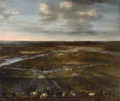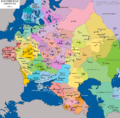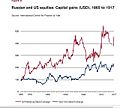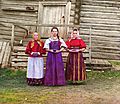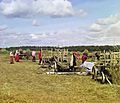Russian Empire facts for kids
Quick facts for kids
Russian Empire
|
|
|---|---|
| 1721–1917 | |
|
Flag
|
|
 |
|
| Capital | St. Petersburg (1721–1728, 1730–1917) Moscow (1728–1730) |
| Government | Absolute monarchy (1721-1906) Constitutional Monarchy (1906-1917) |
| History | |
|
• Established
|
1721 |
|
• Disestablished
|
1917 |
The Russian Empire, also called Imperial Russia, was a country which was located in Europe as well as Asia. It started in 1721 when Peter I of Russia proclaimed it. Before that, it was known as the Duchy of Moscow. It lasted until it was declared a republic in March 1917 after the Russian Revolution. It was an absolute monarchy ruled by Russian emperors known as 'Tsars'. They were members of the House of Romanov and believed that they had the divine right of kings over their people.
In 1914, the Russian Empire covered an area of about 21,799,825 km². In 1897, it had a population of 128,200,000 (1897 year). Its official language was the Russian language. Its official church was the Russian Orthodox Church.
The Russian Empire was led by a Tsar who had complete control of the nation. In this absolute monarchy only Tsar could create and revoke laws. In 1905 the Tsar granted a new constitution in which he shared some power with a partly elected Duma (parliament. The Russian Empire was a great power, and one of the biggest empires that ever existed.
Russian society
Most people in Imperial Russia were peasants. They lived mainly in rural areas until the late 19th century when the Emancipation of the Serfs freed them from the farms where they had to stay. They were allowed to marry whomever they wanted, own property, and vote.
A few people were nobility, also called boyars. They were educated and held higher prestige. Towards the end of the 19th century many of the educated wanted to remove the Tsar and give people more power.
Revolution and after
In 1917 World War I caused the bad conditions of people who worked in factories to become even worse with a food shortage. People blamed it on the Tsar and rebelled. Cities such as St Petersburg and Moscow were faced with riots. The Tsar was soon forced to abdicate in the February Revolution in 1917. After the October Revolution he was assassinated with his family. In 1922 most of the Russian Empire became the Union of Soviet Socialist Republics, or USSR when a communist government won the Russian Civil War. Some of the counties in the Empire escaped but the biggest ones were forced into the USSR.
Images for kids
-
A painting depicting the Battle of Narva (1700) in the Great Northern War
-
Peter the Great officially renamed the Tsardom of Russia as the Russian Empire in 1721 and became its first emperor. He instituted sweeping reforms and oversaw the transformation of Russia into a major European power. (Painting made after 1717.)
-
Empress Catherine the Great, who reigned from 1762 to 1796, continued the empire's expansion and modernization. Considering herself an enlightened absolutist, she played a key role in the Russian Enlightenment. (Painted in the 1780s.)
-
An 1843 painting imagining Russian general Pyotr Bagration, giving orders during the Battle of Borodino (1812) while wounded
-
Franz Roubaud's 1893 painting of the Erivan Fortress siege in 1827 by the Russian forces under leadership of Ivan Paskevich during the Russo-Persian War (1826–28)
-
The eleven-month siege of a Russian naval base at Sevastopol during the Crimean War
-
Russian troops taking Samarkand (8 June 1868)
-
A scene from the First Russian Revolution, by Ilya Repin
-
Russian soldiers in combat against Japanese at Mukden (inside China), during the Russo-Japanese War (1904–1905)
-
Patriarch Tikhon of Moscow in 1917
-
1814 artwork depicting the Russian warship Neva and the Russian settlement of St. Paul's Harbor (present-day Kodiak town), Kodiak Island
-
The Moscow City Duma circa 1900 (colorized photograph)
-
Watercolor-tinted lithgraph, from the 1840s, depicting the arrival of the first Tsarskoye Selo Railway train at Tsarskoye Selo from St. Petersburg on 30 October 1837.
-
The Kazan Cathedral in Saint Petersburg was constructed between 1801 and 1811, and prior to the construction of Saint Isaac's Cathedral was the main Orthodox Church in Imperial Russia.
-
Contemporary painting of the procession of Emperor Alexander II into Dormition Cathedral in Moscow during his coronation in 1856
-
1892 painting depicting Imperial Russian Navy Brig "Mercury" Attacked by Two Turkish Ships in a scene from the Russo-Turkish War (1828–29), by Ivan Aivazovsky
-
1856 painting imagining the announcement of the coronation of Alexander II that year.
-
The 1916 painting Maslenitsa by Boris Kustodiev, depicting a Russian city in winter
-
Peasants in Russia (photograph taken by Sergey Prokudin-Gorsky in 1909)
See also
 In Spanish: Imperio ruso para niños
In Spanish: Imperio ruso para niños



